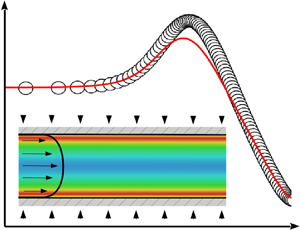Article contents
Extension to various thermal boundary conditions of the elliptic blending model for the turbulent heat flux and the temperature variance
Published online by Cambridge University Press: 20 October 2020
Abstract

A new formulation of the model used in the near-wall region for the turbulent heat flux is developed, in order to extend the elliptic blending differential flux model of Dehoux et al. (Intl J. Heat Fluid Flow, vol. 63, 2017, pp. 190–204) to various boundary conditions for the temperature: imposed wall temperature, imposed heat flux or conjugate heat transfer. The new model is developed on a theoretical basis in order to satisfy the near-wall budget of the turbulent heat flux and, consequently, its asymptotic behaviour in the vicinity of the wall, which is crucial for the correct prediction of heat transfer between the fluid and the wall. The models of the different terms are derived using Taylor series expansions and comparisons with recent direct numerical simulation data of channel flows with various boundary conditions. A priori tests show that this methodology makes it possible to drastically improve the physical representation of the wall–turbulence interaction. This new differential flux model relies on the thermal-to-mechanical time scale ratio which depends on the thermal boundary condition at the wall. The key element entering this ratio is  $\varepsilon _\theta$, the dissipation rate of the temperature variance
$\varepsilon _\theta$, the dissipation rate of the temperature variance  $\overline {{\theta '}^2}$. Thus, a new near-wall model for this dissipation rate is proposed, in the framework of the second-moment closure based on the elliptic blending strategy. The computations carried out in order to validate the new differential flux model demonstrate the very satisfactory prediction of heat transfer in the forced convection regime for all kinds of thermal boundary condition.
$\overline {{\theta '}^2}$. Thus, a new near-wall model for this dissipation rate is proposed, in the framework of the second-moment closure based on the elliptic blending strategy. The computations carried out in order to validate the new differential flux model demonstrate the very satisfactory prediction of heat transfer in the forced convection regime for all kinds of thermal boundary condition.
JFM classification
- Type
- JFM Papers
- Information
- Copyright
- © The Author(s), 2020. Published by Cambridge University Press
References
REFERENCES
- 8
- Cited by





